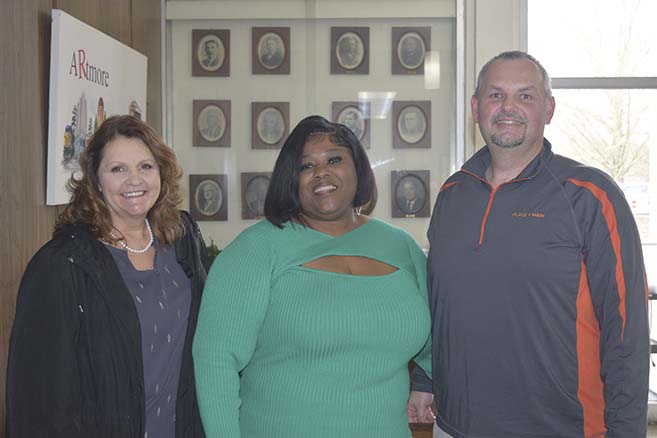
By DON FLETCHER
News Staff Writer
One of the principals of a Michigan-based economic development consulting firm told Main Street Atmore board members, local real estate agents and others during a meeting last Friday, February 10, that the city of Atmore’s downtown area has “a ton of potential,” but has a long way to go before it can fully service the needs of local shoppers.
About 20 people, including seven local real estate agents, crowded into the conference room at Atmore City Hall for a discussion of the rough data accumulated by Place+Main over the past few days, what the data reveals, and some of the strategies for improving the city’s economic picture.
Mary Helmer Wirth, president and state coordinator for Main Street Alabama, explained that the analysis being conducted by the economic development consultants was being provided free through a partnership with Opportunity Alabama.
Joe Borgstrom joined local board members, city officials, business owners, real estate agents and others for a Thursday tour of the area that is considered the downtown trade district, including Poarch, Rivercane, Atmore Industrial Drive and about two dozen downtown businesses.
“The goal of this plan is to help collect market data in downtown, then make overall recommendations for the strategies intended to increase the value of real estate within the business community downtown,” Borgstrom explained. “For the last day-and-a-half, we’ve been here in town. We’ve walked all over downtown and seen some of the surrounding areas. We have used microdata (data from cell phone usage) to help us determine primary and secondary trade areas.”
According to data already gathered by the firm, “about 100,000” people visited the outlined downtown trade area, a total of 827,000 times over the past 12 months. Borgstrom said the average visitor to downtown — individuals who are in the district 10 minutes or more — comes into the district 7-1/2 times a day and stays about an hour and 40 minutes.
He then talked about retail leakage, which he said is a “fancy way of saying the difference in supply and demand.”
“If there is more demand than supply, you have what we call a gap,” he said. “That means, even though you don’t have that supply market, demand still gets met.”
Local shoppers who can’t find what they want or need here shop online or make trips to Mobile, Pensacola, Monroeville and other nearby communities, he noted.
“When you have more supply than demand, you have what you call a surplus,” he continued. “Is that a bad thing? Not necessarily, it depends on what area it occurs in.”
He said preliminary data indicates that local residents spend nearly $816 million each year on “food and stuff,” while the area supplies less than $763 million, creating a gap of about $53 million. He projected that within five years, that gap would grow to $125 million unless more retail offerings are created.
Borgstrom also talked about Main Street Atmore’s “very active” façade grant program, but suggested that waiving the required 50-50 match might spur even more business owners to take advantage of the program.
He also told the people in the room that the city has enough event spaces, that some of those spaces could be better utilized as retail outlets. The consultant also stressed the need for changes to city zoning that will allow for upper-floor housing in the downtown area.
Borgstrom also pointed out that local business property leasing rates are too low, mostly due to the reluctance of property owners to make needed repairs and renovations to their buildings.
“The lease rates here are really, really low, and I don’t mean that in a good way,” he said. “You’re seeing landlords discounting rent instead of making improvements. The people who lease those buildings don’t want to make an equity investment in property they don’t own. You need to raise the bar overall.”
The Main Street Alabama president said local businesses enjoy an impressive level of support from local shoppers.
“The businesses you do have are supported by all the community,” said Wirth. “You just need a little more of them.”
Borgstrom said he would continue to collect data and to analyze the data already collected over the next few weeks before issuing an overall report.
“I’m shooting for the end of March,” he said. “Then we can have a virtual follow-up meeting to go over the report.”
Shinora Redmond is executive director of Main Street Atmore.
